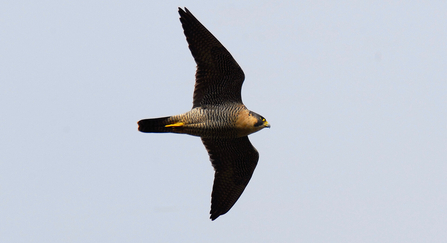Peregrine falcons, the largest falcons that are found in Surrey, are absolutely fascinating because of the characteristics of their anatomy and their super speed! Their maximum wingspan is 1.2 metres, their length is usually about 40 to 54 centimetres, their weight is about 670 grams to 1100 grams and their average life expectancy is six years.
The full taxonomic rank of peregrine falcons is: domain- Eukaryota; kingdom- Animalia; phylum- Chordata; class- Aves; order- Falconiformes; family- Falconidae; genus- Falco; species- peregrinus. So, their binomial name is simply Falco peregrinus. Both peregrine falcons and humans are in the phylum, Chordata. Therefore, the most recent common ancestor of peregrine falcons and humans was a “Chordata”. This animal lived approximately 310 million to 330 million years ago.


